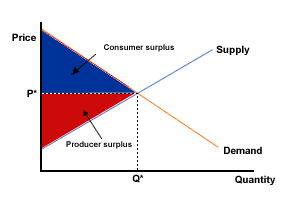Allocative efficiency
Allocative efficiency is an important concept in economics and one we shall return to throughout this module. Allocative efficiency is essentially a situation where consumers are getting the maximum possible satisfaction from the current combination of goods and services being produced and sold. In other words by changing their pattern of consumption and buying different quantities of goods and services, consumers could not increase the satisfaction they are getting.
If we apply this concept at the level of a market, then we can see that society will get the maximum possible benefit when a market is in equilibrium. If we look at figure 1 below, then we can see that at a quantity of Q* (the equilibrium quantity), both consumer and producer surplus are maximised. If the economy was to produce a quantity below Q*, then more consumer and more producer surplus could be gained by a greater quantity being produced and sold of this good.

Figure 1 Consumer and producer surplus
Allocative efficiency requires two different types of efficiency:
- Efficiency in consumption - this is where consumers allocate their incomes in such a way that they get the maximum possible satisfaction from their limited incomes. We assume that this is what all rational consumers are trying to achieve.
- Efficiency in specialisation and exchange - this type of efficiency requires efficient markets where firms specialise in producing and selling and consumers specialise in working so that they can buy goods and services. In this way the markets are as efficient as is possible.
The combination of both these types of efficiency results in allocative efficiency. Allocative efficiency will be increased as long as doing more of something results in a greater marginal benefit to society than marginal cost. As long as this process continues, allocative efficiency will increase. The optimum level of allocative efficiency will be where this process reaches its logical conclusion. In other words where marginal benefit = marginal cost.
